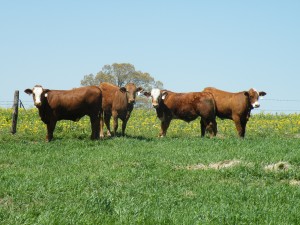Fertilization of winter pasture should be based on a soil test to maximize forage production and prevent applying more fertilizer than is needed. Nitrogen fertilization of small grain and small grain-ryegrass mixtures can be split in 2 to 4 equal applications during the growing season. Two applications are often sufficient in Central Texas with lower rainfall and heavier textured soils. Three or four applications are required on the sandy soils in East Texas because of low nutrient holding capacity and high rainfall. Phosphorus and potassium can be applied at planting. If more than 75 to 80 lbs/acre of potassium are needed on sandy soils in East Texas, it is recommended to split into an autumn and late winter application because of leaching.
Nitrogen fertilization of overseeded ryegrass is usually split in 2 to 3 applications. Phosphorus and potassium, if needed, can be applied at planting. The initial N application should be delayed until after the ryegrass is established to reduce N utilization by the warm season grass and possible leaching in sandy soils. Additional N can be applied in mid winter and early spring.
Overseeded clover-ryegrass may not receive any N or up to 2 applications, depending on the amount of early forage needed. Without N, sufficient forage for grazing will not likely be available until February or early March, depending on location. The most common program is a single application in December to enhance ryegrass production during the winter when there is very little clover growth. Maximum forage production is obtained with 2 applications of N, one after the ryegrass and clover are up and a second in midwinter. Nitrogen should not be applied in the spring if there is a good clover stand. Phosphorus and potassium can be applied at planting or shortly after planting.
Dr. Vanessa Corriher-Olson
Forage Extension Specialist
Soil & Crop Sciences
Overton, TX
Texas A&M AgriLife Extension
